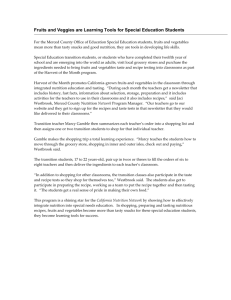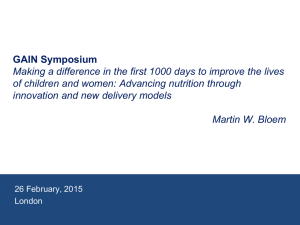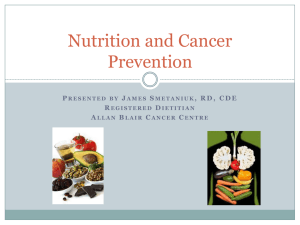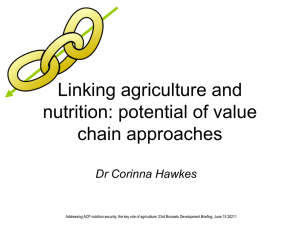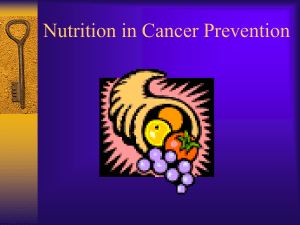Nutrition & Weight Status: Healthy People 2020
advertisement
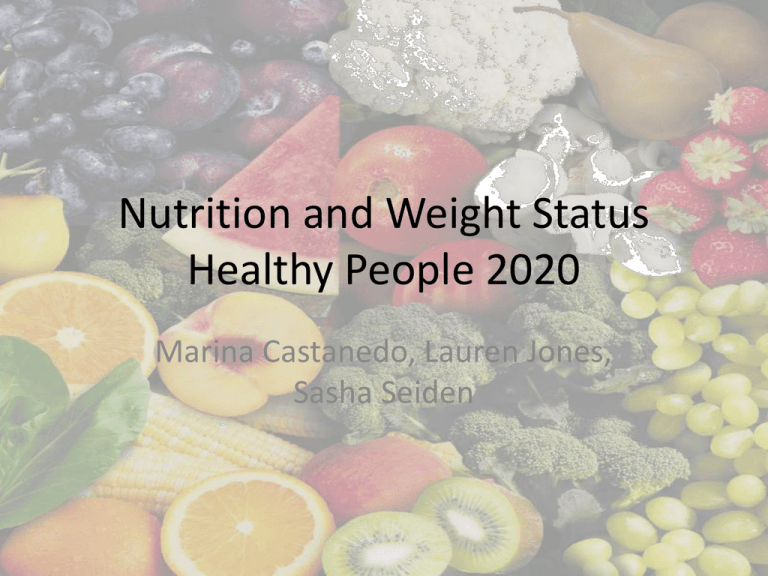
Nutrition and Weight Status Healthy People 2020 Marina Castanedo, Lauren Jones, Sasha Seiden Nutrition and Weight Status • Goal1 – “Promote health and reduce chronic disease risk through the consumption of healthful diets and achievement and maintenance of healthy body weights.” • Overview1 – Healthful diet and healthy body weight – Individual behaviors, policies, and various environments – Household food security and hunger elimination Americans With a Healthful Diet1… • Nutrient-dense foods • Include all food groups • Limit intake of saturated and trans fats, cholesterol, added sugars, sodium, and alcohol • Meet caloric needs • Avoid unhealthy weight gain Americans With a Healthful Diet2 • Eating healthily and exercising regularly can help – Maintain healthy weight – Reduce risk of chronic disease – Promote overall health status – Growth and development in children Weight Loss3 • Advantages of weight loss • How to achieve weight loss – Dietary Therapy – Physical Activity – Behavior Therapy Overview of Objectives • NWS-2.2: Increase the proportion of school districts that require schools to make fruits or vegetables available whenever other food is offered or sold • NWS-10.2: Reduce the proportion of children and adolescents who are considered obese in children aged 6 to 11 years • NWS-10.3: Reduce the proportion of children and adolescents who are considered obese in children aged 12 to 19 years • NWS-12: Eliminate very low food security among children • NWS-13: Reduce household food insecurity and in doing so reduce hunger NWS-10.2 & 10.3 • Baseline: 17.4% of children aged 6-11 years were considered obese. • Target: 15.7% • Baseline: 17.9% of adolescents aged 12-19 were considered obese. • Target: 16.1% Background for 10.2 & 10.3 • Costly condition o +$125 million/yr spent on hospital admittances9 • Lower math & reading scores in kindergarten o Increased behavioral and learning disabilities9 • In 2005-20088 o 17.4% of children (6-11 years) o 17.9% of adolescents (12-19 years) • Increased rates, as well as heavier weights6 Importance of 10.2 & 10.3 • Physically, mentally, academically • Increased risk of chronic disease & premature death • More likely to be overweight or obese adults4 • Economic impact & direct medical costs4 – $14 billion annual in direct health care expenses Importance • Minority youth populations at risk7 o Ages 6-11: o 22% Mexican American o 20% African American o 14% non-Hispanic o Ages 12-19: o 23% Mexican American o 21% African American o 14% non-Hispanic o American Indian children ages 5-18 o 39% overweight/at risk National Programs8 • Let’s Move! o “America’s move to raise a healthier generation of kids” o American Academy of Pediatrics o Chefs Move to School o National School Lunch Program & Breakfast Program o HealthierUS School Challenge State Programs in Washington • Washington State Nutrition & Physical Activity Plan11 o Center for Safe Routes to School o Unplugged12 o 30 Days Live! – students give up TV for a month • Washington State Senate Bill 543612 o Adopt nutrition & physical policies • Washington State Senate Bill 509312 o Encourages healthy food & beverages during school hours, school sponsored activities Local Programs • Boys & Girls Club of Whatcom County6 o SMART Girls5 o Healthy Habits5 • Child Nutrition Program6 o USDA funded o Provide nutritious meals & snacks to childcare centers • Food $ense Nutrition Program in Skagit County3 Gaps • • • • • • • Programs aren’t fully funded2 No programs are aimed towards minority groups Time requirement for PE or recess vary1 Food deserts8 Should incorporate sleep health Food companies market for children Difficult to change attitudes NWS 2.2 Only 6.6% of school districts require schools to make fruits or vegetables available Importance of Objective • School environments impact adolescent diets – 19-50% of daily calories at school12 • Too many unhealthy foods can damage brain2 – Academic impact • Motivation and attention12 • GPA9 • Obesity has more than doubled in last decade in school age children19 Background12 • ¼ of WA students eat 5+ fruits & vegetables a day • 1 in 10 teens in WA are overweight • Shortened lunch periods • 90% of students have easy access to unhealthy food • Focus on prevention, not treatment What are kids eating at school?9 • Food brought from home • Federal school lunch or breakfast programs • Foods sold outside of meal programs – Vending Machines, snack bars, school stores • “Competitive Food” – Much of schools revenue depends on competitive foods • Institutional fear results in unhealthy decision making Competitive Foods9 • Vending Machines found in 17% of elementary, 82% of middle, and 97% of high schools – Low nutrient, energy dense (high calorie) food – Low income vs. high income schools? • Availability of snacks in schools higher calorie intake – Decrease in fruits and vegetables • USDA cannot regulate what is sold outside of mealtime National Programs • Lets Move!6 – Healthier US School Challenge17 • National School Lunch & Breakfast Program13 – Low cost/free lunches to children living in poverty • Fresh Fruit and Vegetable Program16 – Outreach to low income schools • Farm to School programs19 – Child Nutrition Act National Programs • FitPick4 • Healthy Schools Program1 – Make healthy foods at competitive pricing so they are a more available option for schools • CDC & IOM make recommendations and policies consistent with Dietary Guidelines for Americans12 – 5-9 fruits and vegetables a day State Programs in Washington • Bills requiring nutrition and physical fitness policies in schools12 – Encourages school health advisory committees • Farm to School programs19 – Local Farms-Healthy Kids • WA State utilizes federal programs Local Programs • Whatcom County Statistics – 40.4% eligible for federal program assistance • Fit Pick12 – Clark County • Square Foot Nutrition Project20 – Weekly lessons & vegetable growing Cultural Competence12 • Different perceptions of nutrition • Correct knowledge and attitude required when dealing with dynamics of cultures • Delivery of information – Respect and awareness • Goal: Reduce disparities in health outcomes Gaps • Lack of a standard of measure to assess policy strength • Budget cuts in schools • Nutrition programs in schools • Support for agricultural programs • Competitive food NWS-13 • “Reduce household food insecurity and in doing so reduce hunger”1 – 15% of American households unable to acquire adequate food2 – HP 2020 Target goal: 6.0 Percent – Retain 2010 Goal • What is food security? – “access at all times to enough food for an active, healthy life for all household members.” –USDA4 Importance5 • USDA measures food security annually – Domestic food and nutrition assistance programs • Children often shielded from insecurity – 1.3 % of households with children insecure in 2008 • 1/3 of food-insecure households had very low food security 2008 – 6.7 million (5.7 percent of all U.S. households) • Variety of coping strategies National Level • National School Lunch Program5 – Meet Dietary Guidelines for Americans • SNAP (Supplemental Nutrition Assistance Program)6 – Food Stamp Program • WIC (Women, Infants, and Children)7 – Provides state grants to all 50 states – Targets low income, nutritionally at risk populations • Healthy Food Financing Initiative8 – Eliminating Food Deserts in America State Programs • Washington Basic Food Program9 • WIC10 • Department of Agriculture10 – EFAP, TEFAP, CSPF • Partners in Action12 – Strengthen food assistance programs and improve economic security for low-income families and individuals – Improve access to and awareness of food assistance programs Local Programs13 • Bellingham Food Bank14 – Free groceries, open to all. – Food Bank Farm – Food 4 Tots – Small Potatoes Gleaning Project – Milk Money – Victory Gardens Any Questions?


